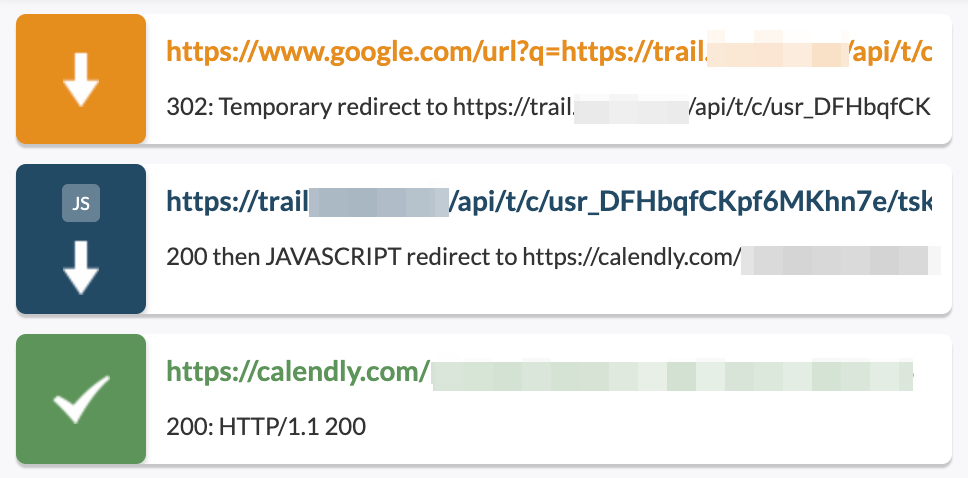Email tracking allows you to collect additional information about the performance of your emails. In the context of cold email, the metrics you can track aside from your reply rate include:
- Open rate – how many times your emails are opened,
- Link clicks – how often links in your emails are clicked.
You wouldn’t be able to analyze either of these metrics when sending regular emails without tracking mechanisms implemented. This makes email tracking an important mechanism for troubleshooting some aspects of your cold email campaigns.
How to implement email tracking
You should use a dedicated tool to track your email link clicks and open rate.
If you’re sending cold email campaigns, find a cold email tool that allows you to track the performance of your emails. Hunter Campaigns lets you individually enable and disable the open rate and link click tracking for every campaign you start.

If you want to track regular emails, such as those you send to your colleagues or existing customers, use a simpler solution like Mailtracker.
How are email opens tracked?
Email opens can be tracked using a tracking pixel – an invisible image that’s added to an email.

When a recipient opens an email, the tracking pixel must be fetched from a server. This means that whenever the message is opened, the server time the message is opened, the server hosting the image records a request, thus tracking email opens.
Email open rate caveats
There are multiple ways in which tracking email opens can give you misleading data:
- For the tracking pixel to be loaded, your message must be displayed in HTML, which isn’t always the case. When a recipient clicks on your email to read it, some clients will open the message as plain text – for example, when the recipient uses a low-speed connection.
- Some email providers pre-load your message's contents before the recipient reads it. This can artificially inflate your open rate.
- Some email clients may also cache the tracking pixel. This means that even though your email will be opened multiple times, you will only record one open event.
- If a recipient reads your email multiple times while offline, the tracking pixel won’t work.
- When a tracked email is forwarded, you won’t know it, but your tracking pixel will track an open event every time the email is opened by consecutive recipients, too. Getting your message forwarded is usually a good thing, but not if you want to measure specifically how many times the initial recipient opened the message.
How are email link clicks tracked?
The mechanism used for tracking email link clicks is based on redirects. When a recipient clicks on a link, they are redirected to the target page through a tracking link, making it possible to log when the link gets clicked.

Benefits of email tracking
Tracking your emails comes with multiple benefits. It gives you additional insight into your campaigns beyond just the replies you get from your recipients.
Tracking open rates can help you optimize subject lines
If you see that your messages aren’t getting opened enough, it’s likely because the subject line doesn’t resonate with your recipients. As you send campaigns, you should continuously test and tweak your subject lines; tracking the open rate can help.
However, remember that your open rate may be low because your emails land in the spam folder. A low open rate should motivate you to troubleshoot your deliverability as well as focus on the subject lines.
Tracking open rates can help you tweak your messaging
If a given message gets opened a lot but doesn’t generate any replies, it means that you have good deliverability and the subject line is working, but the actual content of the email is not. That’s when you need to revise your messaging.
However, keep in mind that getting your emails opened is never the ultimate goal in cold emailing – you should always aim to get replies. A subject line might be provocative, but if it doesn’t match the content and creates anger or confusion with your recipients, it won’t help you generate more replies. On the contrary – it might generate spam complaints and unsubscribes.
Tracking open rates can help you with targeting
Picture this: you send a cold email campaign to 100 recipients. The subject line is: “Save 40% on every customer question resolved.” The content of the message talks about an AI customer support bot that you developed to handle customer complaints, and it can save people money by reducing the customer support workload. Sounds great, right?
And you get ten positive replies from your 100 recipients. An absolutely awesome outcome.
But since you were tracking the open rate, you know only 15 recipients opened your messages, which is rather low.
Your instinct might be to tweak the subject line, but was it necessarily bad? What if it turns out that 70 people on your mailing list never deal with customer complaints?
If your open rate is low, but your reply rate is disproportionately high, it might be because your targeting is off.
Tracking link clicks can help you craft better messages
Adding links to your emails may be a great way to help the recipients take a given action or get more context about your offer.
But if you see that your links aren’t getting clicked, you should react.
Consider the following:
- Is the link unnecessary if you focus on your goal of getting a positive reply?
- Is the resource you’re linking to the best choice in this email?
Cons of email tracking
Email tracking comes with one potential disadvantage: some cold email experts believe that tracking decreases the deliverability of your campaigns.
When your boss sends you an email, it doesn't have open or click tracking. Who’s tracking email opens and link clicks? Marketers… By adding click tracking you are cementing your place in the promotions folder at best. so never track clicks. Never. Impacts delivery too much for cold email. Open tracking is okay, provided you’re using a custom tracking domain.
This could be true for two reasons:
- Some spam filters may block the delivery of emails that contain tracking pixels or tracked links.
- Given that the tracking pixel can’t be used in a plain text email, tracking email opens forces you to send HTML emails, which are thought to have lower deliverability than plain text emails.
For these reasons, consider giving up tracking when experiencing a high bounce rate despite using verified email addresses.
Best practices for email tracking
Taking into account the pros and cons of email tracking, there are several best practices you can stick to when thinking about tracking your own campaigns:
Analyze your open rate in the context of your reply rate
Remember that in most cases, cold emails are meant to generate a positive reply, not an email open. Your open rate might be great, but if it doesn’t translate to positive replies, what good is it for your business? That’s why you should always analyze your open rate in the context of your reply rate.
Take the open rate with a grain of salt
If you’re tracking open rate, remember it’s a metric that’s vulnerable to false positives and may be inflated. And don’t mind the open rate until you’ve sent a substantial amount of emails.
Use a custom tracking domain for link tracking
A custom tracking domain may boost your deliverability. Especially with link tracking, using a custom domain is also better because the links your recipients see in the emails they receive look more natural.
(optional) Track the open rate when launching a campaign, then turn the tracking off.
This is a common tactic among cold email experts. The reasoning behind only tracking the open rate at the beginning is to test your campaign’s deliverability on a subset of recipients, then remove the tracking pixel to maximize your deliverability for the remaining recipients.
Next steps
If you do decide to implement any type of tracking for your campaigns, I strongly encourage using a custom tracking domain to minimize the impact of tracking on the success of your campaigns.

